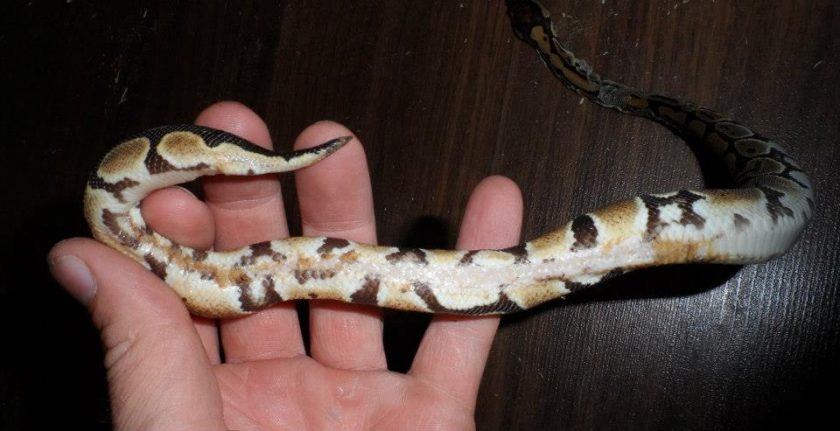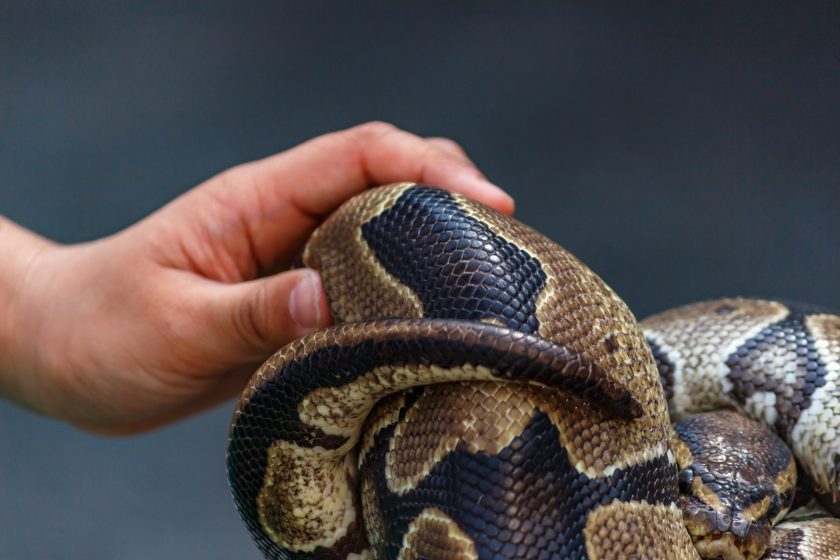It’s a good thing scale rot produces obvious symptoms, as it is a very serious illness. Without rapid care, most snakes that suffer from severe cases of the ailment are likely to die. And unfortunately, many will still succumb even with prompt care, so – like most other ailments that afflict snakes – prevention is key.
But on the positive side, with proper habitat hygiene and maintenance, it is usually a disease you can prevent your snake from getting in the first place.
What Does Scale Rot Look Like?
Called ulcerative or necrotic dermatitis by veterinarians, scale rot can vary in appearance from one snake to the next. And because it is a progressive condition, it can also vary in appearance over time. However, classic, full-blown scale rot is generally easy to recognize.
Once the disease has reached an advanced state, scale rot causes a number of open wounds or ulcers to form on your snake’s skin. These ulcers may affect any part of your snake’s body – they may even cover him from head to tail. However, scale rot typically develops on the ventral and lateral surfaces first.
The ulcers may ooze a bit of blood or fluid, and simply put, they’ll look pretty disgusting. Left untreated, the wounds will get worse and may grow in size.

Scale Rot Early Signs
While advanced scale rot usually causes large, open wounds to form, there are often subtle (and not-so-subtle) signs that precede the appearance of ulcers. And because scale rot is easiest to treat early, it is important that keepers learn to recognize the earliest signs of the condition.
Typically, the first thing observant keepers may notice is the appearance of small red spots in the scales. But shortly thereafter, a more obvious symptom will occur: Small, fluid-filled blisters will appear on the snake. These blisters are generally immediately apparent, and they’re usually found in fairly large numbers.
What Causes Scale Rot in Ball Pythons?
A variety of pathogens can cause scale rot, but it is generally some type of bacteria or fungi that triggers the ailment.
Poor enclosure hygiene, excessive habitat moisture or a filthy substrate can all allow these pathogens to proliferate (and they’ll also cause stress, which can dampen the snake’s immune response). This is part of the reason that it is so important to keep your pet’s habitat clean and remove feces, urates, or shed skin as often as possible. It is also imperative that you ensure adequate habitat ventilation and clean up any spilled water promptly
Once the ulcers have developed, a variety of secondary pathogens can colonize your snake. This will further weaken your snake and often result in septicemia (blood poisoning).
It bears mentioning that some snakes appear to develop scale rot even though they’re kept in pristine conditions. It isn’t clear why these animals develop the disease, but it may be due to stress or poor general health.
How to Prevent Scale Rot
Because scale rot can be such a serious illness and it is not always easy to treat once it develops, prevention is vital. While it is true that a small number of snakes seem to develop the condition for inexplicable reasons, the majority of snakes who end up with scale rot have been forced to live in dirty, damp or unkempt enclosures.
Accordingly, it is important to clean your snake’s habitat frequently and ensure that it provides enough ventilation to avoid becoming damp. Minimally, this means cleaning the habitat walls, water dish, and hides each week, while also spot-cleaning the substrate. If possible, it would be even wiser to spot-clean the habitat every day.
Additionally, you’ll want to clean the habitat completely, in top-to-bottom fashion, once every four to six weeks. This includes completely emptying the habitat, washing all of the dishes and furniture, and discarding the old substrate. Sanitize the entire enclosure with a snake-safe disinfectant, and then allow it to dry (in the sun, if possible).
Then, you can add fresh substrate to the enclosure, add the furniture and water dish back, and then return your snake to his home. It is also wise to inspect your snake regularly and remain on the lookout for any potential signs of trouble.
How to Treat Scale Rot
Scale rot is not easy to treat, and there’s little the average snake keeper can do to treat it at home. It will almost always require veterinary assistance, although you will need to maintain incredibly strict enclosure hygiene while the snake is undergoing treatment.
Your vet will likely treat your pet by administering antibiotics. He or she may take samples from some of the ulcers and have them cultured to determine the bacteria or fungi causing the problem and guide the choice of antibiotics. However, other vets may just prescribe broad-spectrum antibiotics and hope for the best.
Supportive care – including additional fluids, electrolytes or calorie replacement – may also be necessary. This is particularly true of animals battling severe cases of scale rot.
Take care!
Scale rot is certainly a very serious condition, but it is important to avoid panicking if you suspect your snake is suffering from the condition. Just go ahead and clean the habitat thoroughly, try to keep your snake’s stress level low, and ensure that the temperatures and humidity in the habitat are at ideal levels. Then, give your vet a call and heed the advice provided.
We hope that you’ve found this article helpful, and we’d appreciate you sharing with your snake-keeping friends if you think it’ll help them. Have you ever been faced with a ball python with scale rot before? How did you treat it? Did the treatment work? Let us know in the comments below!


2 Comments
I traded ( like an idiot ) a YellowBelly banana Enchi leopard
Male baby , for a 450g male pastel axanthic and a spotnose leopard. Also have them
A iPhone XR used. Don’t shame me ;( I was scammed. Anyway the axanthic was 450g. So about 6-8 months old. Leopard spot was 65g and I was told she never ate. Just hatched. Well a week later she ate love mouse. And yesterday another live. I wanted the axantic so much being as I have a cinnamon Enchi pin and a super pastel mojave hypo. Well he’s dead. I met the guy off Facebook in a dark Wawa parking lot. I could see wel enough that they weee what they said they were , and I sexed them. They rushed me a lot! Like hurry we gotta go. So whatever I said bye and thank you.
This guy told me on Facebook where I met him that he’s been breeding for 10 years. I put snow (pastel axanthix ) right into his tub because he was literally in end of shed so he looked bad. Pike bad humidity or something I’m not sure. I didn’t take a good look though so they could rest. Next morning I take him out. He shed. All in one price. Wow was he amazing !!!!!! Until I turned my
Kitchen light on. Blisters or burns all over his belly , spine ,
Cloaca, neck , face. I have NEVER in 15 years of keeping MOST pythons and boas, seen anything like it ! Right away I knew it was scape rot. Just because it’s the only thing I haven’t dealt With. Cured mites a few tokens, mouth rot , RI, bad sheds, cuts. This literally made me cry!!!!!wish I could show you. Rainbow Serpent’Sss is my name on Facebook look me up. He was so sweet too. So I tried feeding him twice. Nothing. I have him 2 betadine baths and neosporin once a night for a week. He looked better but one night he was acting weird. Lifting his head up a a lot. Opening mouth. So I had strong instinct he would be gone on the morning.
Now get this …….the guy who is a “pro breeder” said to me that I must have done that to him overnight. Burns or something.
I am no PRO breeder , but I’m about to breed for my second time, 2 adults 2
Babies. So next couple years I’ll grow the business. Although you can ask me anything about the breeding process and care of any Constrictor and even most other reptiles and animals and I will nail it. I have read all my libraries books on animals and care in captivity since I was 12 lol. First ball python. At 16. First retic at 18ish. Was only into them for pets. A BIG pet. Not FEMALE!!!! Lol. Except for boas. Until 2.5 years ago when I saw there werenaboutn100 ball python genetics that were affordable and that maybe I could make some extra money at the same time doing what I love.
That guy did that on purpose. For sure. I have never. Even in pictures , seen such a suffering snake. It still hurts. Of someone messages me on FB I’ll share his messages.
I’m sorry that you experienced this, Michael. It’s heartbreaking to see a snake in that much pain, and it’s even more frustrating when it’s clear that someone has deliberately caused that pain. It sounds like you did everything you could to try and save him, but unfortunately, sometimes scape rot is just too severe for even the best of caretakers to overcome.
I know it’s difficult to lose a pet. I hope you can find some solace in the fact that you are a good snake owner and caretaker, and that you will continue to breed beautiful snakes for people who love them.
Thank you for sharing your story.